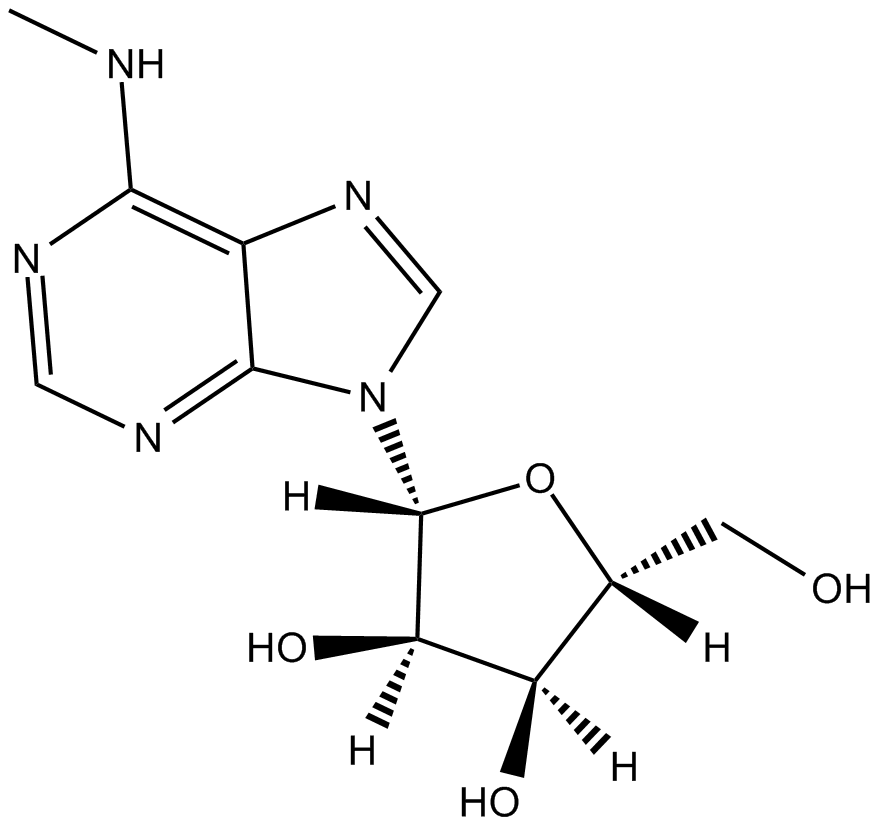N6-methyladenosine (m6A) (Synonyms: NSC 29409) |
| Catalog No.GC14698 |
N6-methyladenosine (m6A) is the most prevalent internal (non-cap) modification present in the messenger RNA (mRNA) of all higher eukaryotes.
Products are for research use only. Not for human use. We do not sell to patients.

Cas No.: 1867-73-8
Sample solution is provided at 25 µL, 10mM.
N6-methyladenosine (m6A or N6m), an adenosine agonist, of an ED50 value of 17.250 µM [1], is a regulator of adenylate cyclase [2]. As a modification in the messenger RNA (mRNA), it is the most prevalent internal (non-cap) modification of mRNA in all higher eukaryotes. It is involved in the regulation of mRNA stability [3].
Adenylate cyclase catalyzes the formation of cyclic adenosine 3’,5’-monophosphate (cAMP) from ATP [4]. In Calu-6 cells, cAMP increased the stability of human rennin mRNA [5].
Concentration-dependently, N6m prevented the accumulation of hemoglobin and inhibited the initiation of commitment to terminal maturation. Treatment with N6m made cell growth slower, but it did not substantially inhibit DNA synthesis and markedly decrease viability and clonogenic potential of MEL cells. In MEL cells, treatment with N6m resulted in a decrease in the accumulation of βmajor globin mRNA in cytoplasm and affected the structural integrity of this mRNA. The inhibition of commitment induced by N6m was potentiated by adenine, l-homocysteine and/or l-methionine. Adenine, l-homocysteine and l-methionine are involved in the active methylation cycle [6].
In mammals, RNA m6A modification preferentially occurs within the consensus sequence RRACH (R = G or A; H = A, C or U) in 3’ UTRs and gene coding regions. That means m6A plays fundamental roles in the control of RNA processing and translational [7].
References:
[1]. Ribeiro JA and Sebastio AM. On the type of receptor involved in the inhibitory action of adenosine at the neuromuscular junction. Br J Pharmacol, 1985, 84(4):911-8.
[2]. Londos C, Wolff J and Cooper DMF. Adenosine as a regulator of adenylate cyclase[M]//Purinergic receptors. Springer Netherlands, 1981:287-323.
[3]. Wang X, Lu Z, Gomez A, et al. N6-methyladenosine-dependent regulation of messenger RNA stability. Nature, 2014, 505(7481): 117-120.
[4]. Salomon Y, Londos C and Rodbell M. A highly sensitive adenylate cyclase assay. Analytical biochemistry, 1974, 58(2): 541-548.
[5]. Sinn P L and Sigmund CD. Human renin mRNA stability is increased in response to cAMP in Calu-6 cells. Hypertension, 1999, 33(3): 900-905.
[6]. Vizirianakis IS, Wong W and Tsiftsoglou AS. Analysis of the inhibition of commitment of murine erythroleukemia (MEL) cells to terminal maturation by N 6-methyladenosine. Biochemical pharmacology, 1992, 44(5): 927-936.
[7]. Zhao X, Yang Y, Sun BF, et al. FTO-dependent demethylation of N6-methyladenosine regulates mRNA splicing and is required for adipogenesis. Cell research, 2014, 24(12): 1403-1419.
Average Rating: 5 (Based on Reviews and 24 reference(s) in Google Scholar.)
GLPBIO products are for RESEARCH USE ONLY. Please make sure your review or question is research based.
Required fields are marked with *




















